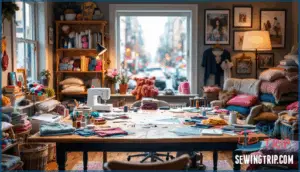This site is supported by our readers. We may earn a commission, at no cost to you, if you purchase through links.
 You’ve probably scrolled past a hundred ‘learn to sew’ ads promising instant mastery, but here’s the truth: you don’t need another expensive course or a fancy sewing room to master this skill. Armed with just a basic machine, some fabric scraps, and a decent internet connection, you can teach yourself to sew from your kitchen table.
You’ve probably scrolled past a hundred ‘learn to sew’ ads promising instant mastery, but here’s the truth: you don’t need another expensive course or a fancy sewing room to master this skill. Armed with just a basic machine, some fabric scraps, and a decent internet connection, you can teach yourself to sew from your kitchen table.
The real key isn’t where you learn—it’s having the freedom to pause, rewind, and practice that tricky French seam at 2 a.m. without judgment. Online sewing breaks all the old rules about needing in-person classes or years of training, putting you in control of both the pace and the projects you tackle first.
Table Of Contents
- Key Takeaways
- Benefits of Online Sewing Classes
- Beginner Friendly Online Sewing Courses
- Essential Supplies for Learning to Sew
- Choosing Fabric for Beginner Sewing Projects
- Finding The Right Sewing Patterns
- Top Tips for Learning to Sew Online
- Easy Beginner Sewing Projects
- Share Your Sewing Journey
- Frequently Asked Questions (FAQs)
- Conclusion
Key Takeaways
- Online sewing education gives you complete control over when and where you learn, letting you pause, rewind, and practice difficult techniques without the rigid schedule or high costs of traditional in-person classes.
- You can start learning to sew with minimal investment—free courses from platforms like Alison, Udemy, and Skillshare provide structured lessons and expert instruction without spending a dime.
- Beginner-friendly fabrics like cotton and linen forgive mistakes and behave predictably, while simple projects like aprons and tote bags build real skills you’ll actually use in everyday life.
- Connecting with online sewing communities transforms solo frustration into collaborative problem-solving, giving you instant feedback, troubleshooting help, and motivation to finish projects you’d otherwise abandon.
Benefits of Online Sewing Classes
Learning to sew online isn’t just about watching a few videos and hoping for the best. It’s about finding a learning style that actually fits your life, doesn’t drain your wallet, and connects you with people who know their stuff.
Here’s why taking your sewing education online might be the smartest move you’ll make this year.
Flexibility of Scheduling
One of the best perks of learning to sew online? You’re in complete control of when you hit the pedal, so you can squeeze in lessons during your lunch break, late-night creative bursts, or lazy Sunday afternoons—no need to rearrange your entire schedule around rigid class times.
This self-paced learning approach means you can:
- Pause and rewind sewing lessons online whenever you need clarity
- Build tailored plans that match your energy and availability
- Master time management without sacrificing your day job or social life
- Access your free online sewing course from any device, anywhere
That’s the freedom online sewing schools deliver.
Affordability of Instruction
Beyond the time savings, online sewing courses won’t empty your wallet the way traditional in-person classes can—you’ll find everything from totally free beginner courses to premium instruction that still costs a fraction of what you’d pay at a local studio.
Cost-effective online sewing courses and budget sewing tutorials give you affordable classes without compromising quality. Free sewing resources and low-cost patterns mean you’re investing in skills, not expensive overhead.
Accessibility to Experts
What really sweetens the deal is that online sewing classes connect you with expert instructors from around the world—people who’ve spent decades perfecting their craft and now teach from studios you’d never be able to visit otherwise.
Expert feedback and mentor guidance from these online tutors mean you’re learning proven techniques through virtual workshops with real support:
- Online sewing school instructors respond to your questions directly in course forums
- Sewing lessons online include video feedback on your actual projects
- Community support connects you with fellow students troubleshooting together 24/7
- Learn to sew from award-winning designers sharing their signature methods
- Sewing community networks give you access to pattern makers and tailors worldwide
Beginner Friendly Online Sewing Courses
You’ve got options in learning online, and not all of them require opening your wallet. Some of the best courses out there won’t cost you a dime, while others offer structured lessons that take you from thread to finished garment.
Let’s look at where you can find solid instruction that actually works.
Free Sewing Courses Online
You don’t need expensive sewing lessons online to start building serious skills—free online sewing courses deliver real results. Platforms like Alison offer six CPD-accredited courses averaging 2–3 hours each, while Udemy’s free "Learn to Sew" tutorial clocks in at one hour with a certificate included.
Skillshare, Made to Sew, and Anita By Design provide free mini course options covering everything from sewing basics to pattern drafting. Online tutorials let you master threading machines, straight stitches, and troubleshooting at your own pace, and the sewing community shares millions of views worth of beginner-friendly content.
These sewing resources prove you can learn to sew without spending a dime—just bring your curiosity and a willingness to practice. Many courses also offer expert sewing instruction with clear videos.
Learn to Sew Classes
Structured online sewing courses turn curiosity into confidence, fast. Programs like Sew It Academy—serving over 800,000 students—teach sewing basics through bite-sized lessons covering sewing machines, fabric choices, and beginner projects like tote bags and cushion covers.
Online tutorials guide you through fundamentals such as threading, straight stitching, and pattern reading, while sewing lessons online from platforms like Skillshare and Udemy deliver expert instruction at your own pace.
These online sewing courses for beginners transform fabric choices and technique into wearable wins, proving that learning to sew doesn’t require a classroom—just commitment and the right digital guide. With the flexibility of online sewing courses, students can learn at their own pace and access a wide range of sewing techniques and patterns.
Essential Supplies for Learning to Sew
Before you click "buy" on that first sewing machine, let’s talk about what you actually need to get started—because showing up prepared beats scrambling for supplies mid-project every time.
Your essential sewing tools don’t require a second mortgage. Start with a basic sewing kit containing straight pins, hand-sewing needles, and a seam ripper—trust me, you’ll use that ripper more than you’d like. Grab fabric scissors (and never, ever use them on paper), a measuring tape, and a few thread colors that match your first fabric types. Cotton thread works for most beginner projects.
For sewing notions, you’ll want pattern weights or pins, tailor’s chalk, and a pincushion. If you’re getting a machine, learn its parts before your first class—bobbin, presser foot, tension dial. Most sewing supplies needed cost under $50 total. You’re building skills, not stocking a factory. Keep it simple, and add specialized sewing tools as you grow.
Choosing Fabric for Beginner Sewing Projects
Picking the right fabric can make or break your first sewing project, so you don’t want to grab just anything off the shelf. Some materials forgive mistakes, while others fight you every step of the way.
Here’s what you need to know about choosing fabrics that’ll actually help you succeed.
Fabric Selection Tips
Picking the right fabric can feel like standing in front of a wall of color and texture with no map, but a few smart guidelines will turn that overwhelming moment into your first real win. Start by checking the weave patterns and fiber blends—look for stable, forgiving fabric types that won’t shift or fray easily.
Many online sewing tutorials and sewing courses recommend matching thread colors and understanding textile care before you cut, so your fabric crafting doesn’t unravel later.
Beginner-friendly Fabric Options
Cotton, linen, and quilting cotton are your best friends when you’re just starting out—they behave predictably, forgive mistakes, and won’t make you want to toss your machine out the window. Stick with medium fabric weights in solid or simple print choices—they’re easier to cut and sew than slippery knits or heavy textures.
Most sewing lessons online recommend 100% cotton fabric for your first projects, and there’s a reason: it’s the rebellion you can actually win.
Considering Project Requirements
Not every fabric works for every project—choosing the wrong material is like wearing flip-flops to a snowstorm. Before you buy, think about what your sewing project actually needs: a tote demands sturdy canvas, while a simple pillowcase thrives on soft cotton.
Smart fabric selection matches your sewing patterns to your sewing skills development and available sewing tools.
Finding The Right Sewing Patterns
You’ll stumble way less once you crack the code of sewing patterns—they’re your blueprint for success, not some cryptic puzzle. Start here:
- Grab beginner-marked patterns from the Big 4 brands (Simplicity, McCall’s, Butterick, Vogue) or explore indie designers—over 70% of new sewists choose "easy" labels with 3–5 pattern pieces and no tricky closures.
- Go digital if you want instant access—PDF patterns now make up 53% of purchases, and you can download them immediately from sites listing thousands of options.
- Read community reviews before buying—about 67% of sewists rely on feedback to pick winners, especially for garment fitting accuracy.
- Match patterns to your fabric choices—understanding pattern requirements helps you nail sewing basics and avoid frustration with material mismatches.
Digital patterns with step-by-step tutorials give you the freedom to learn pattern making and alterations at your own rebellious pace.
Top Tips for Learning to Sew Online
Once you’ve got your patterns locked in, the real breakthrough is learning smart—not just learning more. Online sewing courses work best when you match them to your learning styles and sewing pace—nobody’s timing you, so ditch the pressure and embrace the freedom.
- Connect with online tutors and virtual workshops—over 1.2 million sewists swap sewing techniques for beginners through forums, and apps like Knot Alone offer 24/7 expert feedback when you’re stuck at midnight.
- Replay sewing tutorials until it clicks—that’s the beauty of sewing lessons online. Rewind, pause, practice—your way.
- Track your wins to fuel sewing motivation—snap photos of your progress, celebrate the messy first attempts, and watch yourself evolve from clueless to confident.
Learning to sew online means you control the adventure, mistakes included.
Online sewing lets you own your mistakes and your victories—no schedule, no judgment, just raw progress on your terms
Easy Beginner Sewing Projects
Now that you’ve got the basics down, it’s time to actually make something. These two projects are perfect for building confidence without getting overwhelmed.
Let’s start with something you can finish in an afternoon and actually use.
Apron
An apron is one of those forgiving first projects that won’t punish your rookie mistakes—straight seams, basic shapes, and you’ll actually use the thing when you’re done. You can pick a simple waist apron or level up to a full bib apron, depending on how adventurous you’re feeling.
Most sewing patterns break it down step-by-step, so you’re never lost. Go for sturdy cotton or linen that’ll withstand flour explosions and paint splatters.
Tons of sewing lessons online walk you through apron designs, teaching core sewing techniques while you create something genuinely useful—not bad for your first real sewing project.
Tote Bag
Tote bags are your advanced move—they teach you grips, linings, and maybe a zipper if you’re feeling bold, all while giving you something practical to carry groceries or fabric scraps.
Canvas or denim work great for bag construction—they’re sturdy enough to support your stuff without sagging. Play around with strap designs (sewn straps or webbing) and experiment with lining techniques to hide those messy seams.
You’ll find tons of tote bag patterns in online sewing courses that walk you through these fabric crafting skills, turning basic sewing techniques into real-world sewing projects you’ll actually want to show off.
Share Your Sewing Journey
After you’ve stitched up your first project or two, the real fun begins when you start connecting with other sewists online. Joining a sewing community gives you instant access to feedback, troubleshooting help, and that push you need when a seam goes sideways. Share your personal projects—messy mistakes and all—because that’s where real learning to sew happens.
Here’s what makes sharing your sewing journey worth it:
- Get unstuck fast: Post a question at midnight, get answers by breakfast from sewists worldwide
- Fuel your creative expression: Seeing others’ work sparks ideas you’d never think of alone
- Set bigger sewing goals: Community accountability turns "someday" projects into finished pieces
- Master skill sharing: Teaching someone else cements what you’ve learned
- Find your people: Sewing education works better when you’ve got cheerleaders celebrating your wins
Sewing community support transforms solo frustration into collective problem-solving. That’s how sewing for beginners becomes sewing with confidence.
Frequently Asked Questions (FAQs)
How do I learn to sew online?
Learning to sew online is simpler than you think. Dive into virtual classes, follow online tutorials, explore digital patterns, and join sewing communities for support while mastering online sewing courses at your own pace.
Is this free online sewing course right for You?
If you’re keen to break free from store-bought patterns and crave creative control, this free mini course is your launchpad.
It’s perfect for evaluating your learning pace, sewing motivation, and personal goals before committing to a full beginner sewing course online.
What is this free online sewing course for beginners?
This beginner sewing course breaks down sewing basics through structured online sewing lessons.
You’ll master essential sewing techniques, from threading your machine to completing real projects, all while connecting with a supportive sewing community through free mini course modules and online resources.
Where can I find free sewing tutorial videos?
You know what they say: the best teacher is free, and YouTube is packed with them. YouTube tutorials and sewing channels offer thousands of free video lessons, while sewing blogs and online forums add written guides to build your skills through every online sewing lesson available.
What is starting to sew?
Starting to sew means getting hands-on with sewing basics—machine setup, thread selection, fabric prep, and sewing safety.
These beginner sewing lessons lay the foundation for your sewing course, turning curiosity into real skills you can use.
How do I fix common sewing mistakes?
Everyone makes sewing mistakes—it’s how you learn. Thread tangles? Re-thread carefully. Fabric frays? Use pinking shears or fray check. Stitch errors or seam rippings? Embrace your seam ripper.
Mastering these sewing techniques turns bobbin issues into confidence.
What sewing machine features should beginners prioritize?
Forget fancy bells and whistles—your first sewing machine needs solid basics.
Prioritize adjustable machine speed for control, clear thread tension settings, and essential stitch options.
Automatic threading and a top-loading bobbin type make learning basic sewing skills less frustrating.
How long does it take to learn basic sewing?
You can pick up basic sewing skills in about four to six weeks with steady practice. Most sewing courses for beginners break the learning curve into bite-sized chunks, teaching fundamental techniques quickly so you’re stitching real projects before you know it.
Can I learn sewing without a machine?
Yes, you can absolutely start with hand sewing—no machine required. Hand sewing basics like needle work and manual stitches teach you fabric manipulation and core sewing techniques.
It’s a solid way to build sewing skills before investing in equipment.
What are the best online sewing communities?
Think of sewing communities as vibrant quilting circles meeting in the digital town square. Reddit and Facebook host over 2 million sewists sharing techniques, while Sew It Academy connects students worldwide through online sewing courses and virtual workshops.
Conclusion
Your sewing machine isn’t just equipment—it’s a key unlocking creative independence you’ve always had inside you. Every stitch you practice builds confidence, turning intimidating patterns into conquerable challenges.
When you learn how to sew on your own online, you’re not just acquiring a skill; you’re claiming the freedom to repair, create, and customize without waiting for permission or approval.
So thread that needle, embrace the wonky seams, and start stitching your way toward genuine self-reliance.












